CGAN笔记总结第二弹~
CGAN原理与源码分析
一、复习GAN
生成式对抗网络(Generative Adversarial Networks)是让两个神经网络进行博弈进行学习。基础结构包含生成器和判别器。生成器的目标是生成与真实图片相似的图片,以假乱真,尽可能地让判别器判断生成的图片是真实的。判别器的目标是能够区分真实图片和生成图片。生成器和判别器通过巧妙地设计损失函数,而结合在一起,在相互对抗中不断调整各自的参数,使得判别器难以判断生成器生成的图片是否真实,从而达到欺骗人眼的效果。
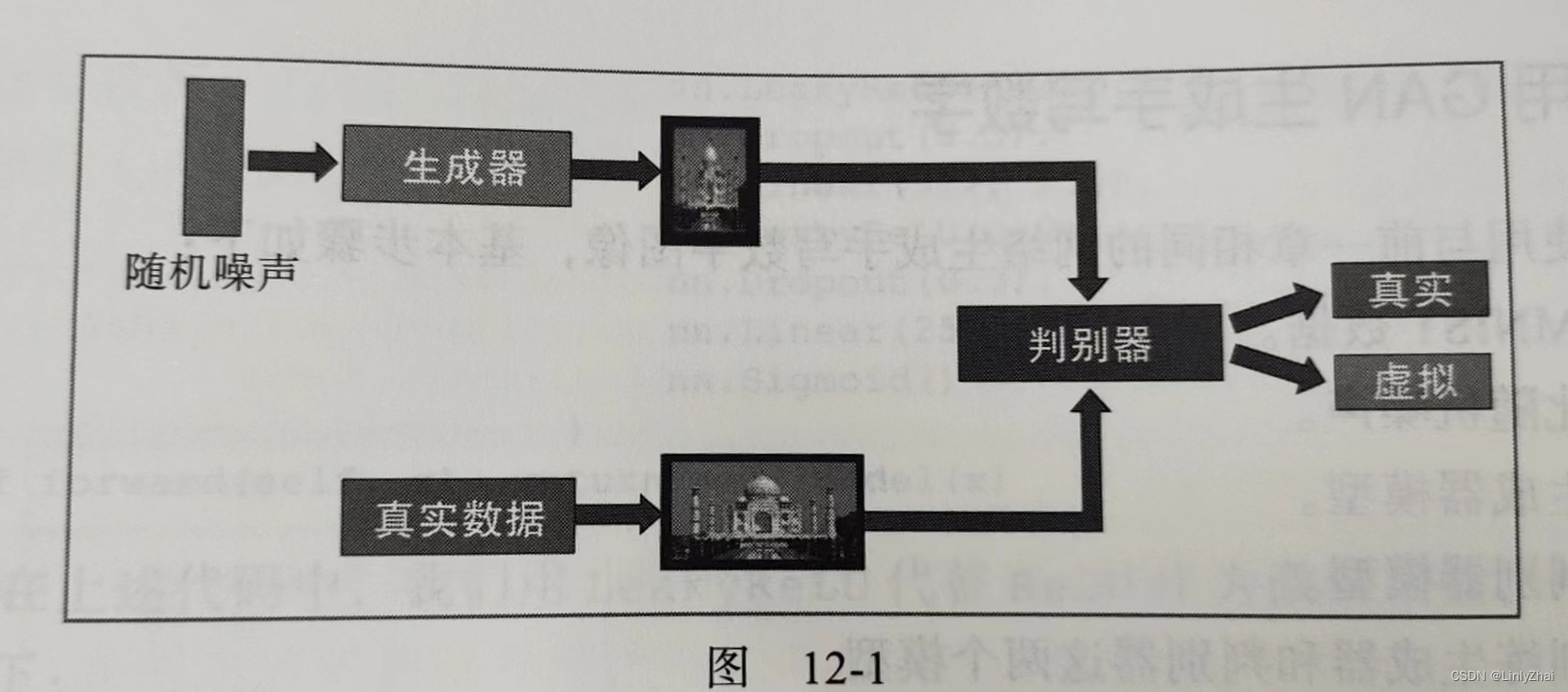
1.1损失函数

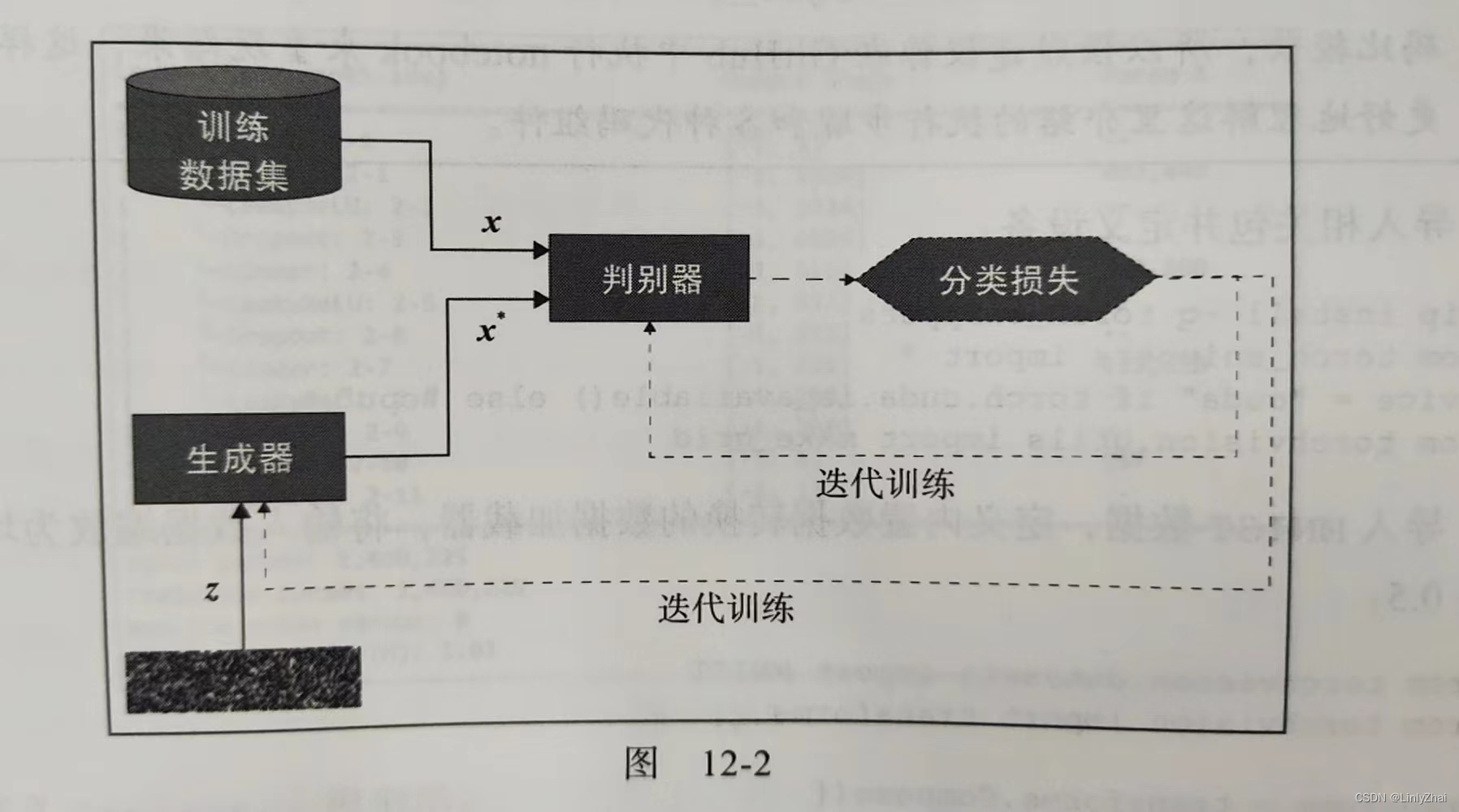
1.2判别器源码
class Discriminator(nn.Module):
def __init__(self):
super().__init__()
self.model = nn.Sequential(
nn.Linear(784,1024),
nn.LeakyReLU(0.2),
nn.Dropout(0.3),
nn.Linear(1024,512),
nn.LeakyReLU(0.2),
nn.Dropout(0.3),
nn.Linear(512,256),
nn.LeakyReLU(0.2),
nn.Dropout(0.3),
nn.Linear(256,1),
nn.Sigmoid()
)
def forward(self, x):
return self.model(x)
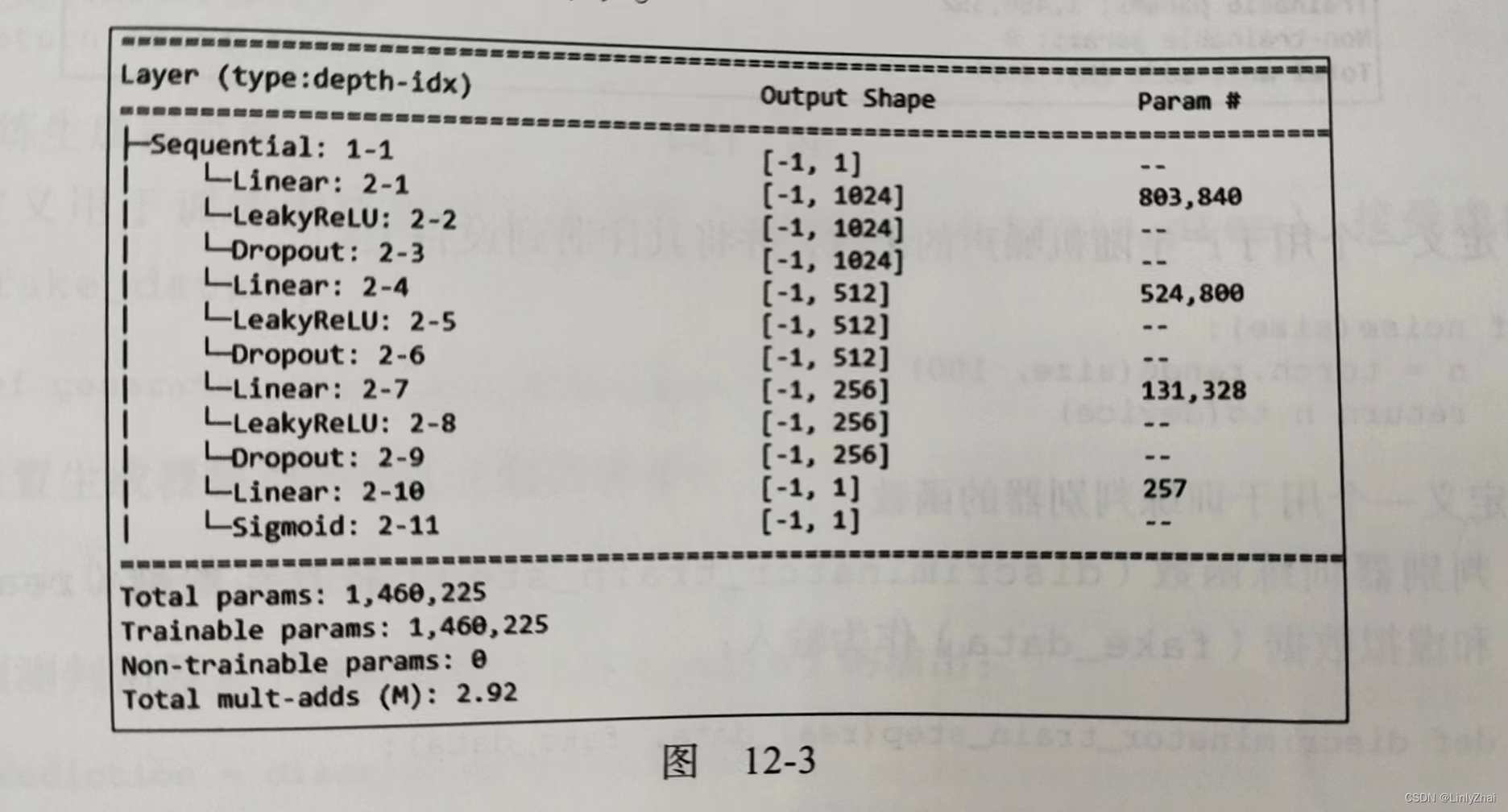
1.3 生成器源码
class Generator(nn.Module):
def __init__(self):
super().__init__()
self.model = nn.Sequential(
nn.Linear(100,256),
nn.LeakyReLU(0.2),
nn.Linear(256,512),
nn.LeakyReLU(0.2),
nn.Linear(512,1024),
nn.LeakyReLU(0.2),
nn.Linear(1024,784),
nn.Tahn()
)
def forward(self, x):
return self.model(x)
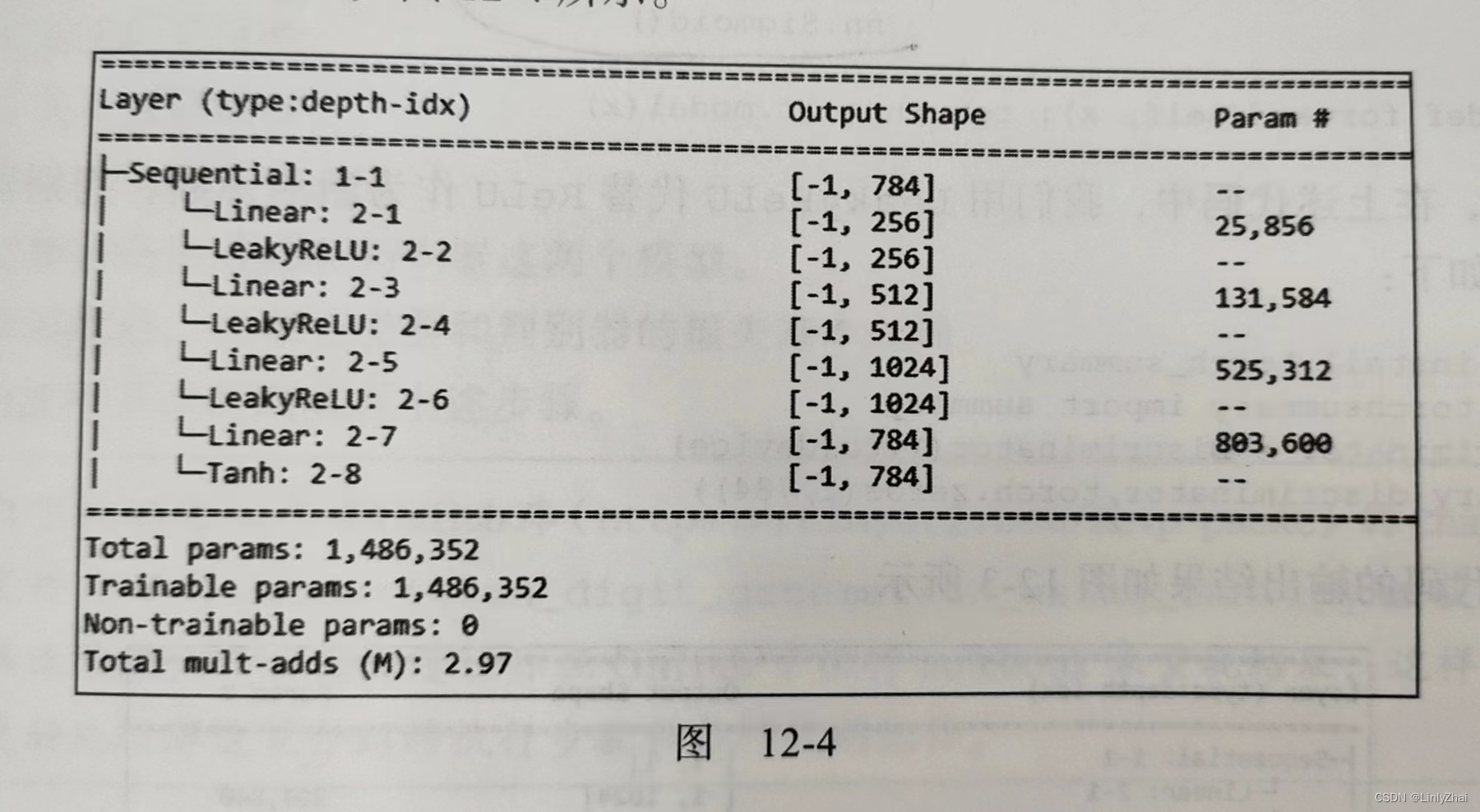

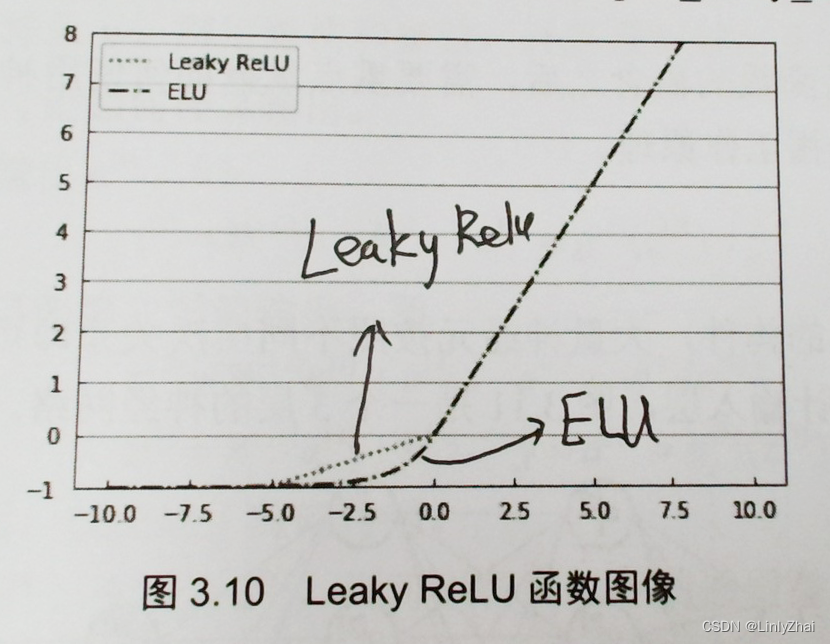
二、什么是CGAN?
CGAN,全称Conditional Generative Aderversarial Networks.与GAN相比,条件GAN加入了额外信息c,从而能够生成指定的手写数字。
2.1 CGAN原理图
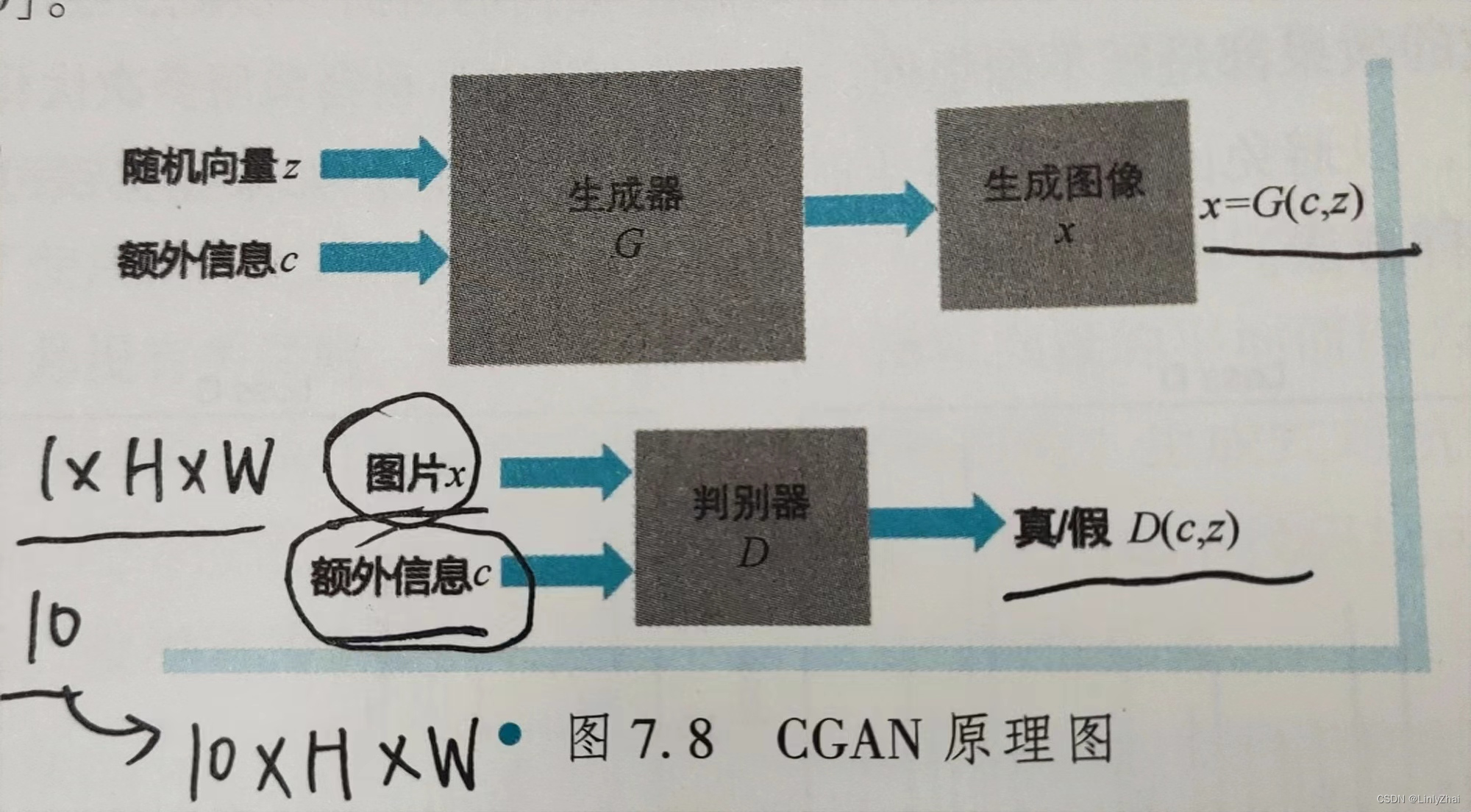
2.2条件GAN的损失函数

nn.BCELoss()是一个PyTorch中的损失函数,它被用于二分类问题。BCE代表二元交叉熵(Binary Cross Entropy)
这里用到的是二元交叉熵损失函数
D(x)代表的是判别器判别图片是真的概率;
在
2.3 生成器源码
class Generator(nn.Module):
def __init__(self, num_channel=1, nz=100, nc=10, ngf=64):
super(Generator, self).__init__()
self.main = nn.Sequential(
# 输入维度 110 x 1 x 1
nn.ConvTranspose2d(nz + nc, ngf * 8, 4, 1, 0, bias=False),
nn.BatchNorm2d(ngf * 8),
nn.ReLU(True),
# 特征维度 (ngf*8) x 4 x 4
nn.ConvTranspose2d(ngf * 8, ngf * 4, 4, 2, 1, bias=False),
nn.BatchNorm2d(ngf * 4),
nn.ReLU(True),
# 特征维度 (ngf*4) x 8 x 8
nn.ConvTranspose2d(ngf * 4, ngf * 2, 4, 2, 1, bias=False),
nn.BatchNorm2d(ngf * 2),
nn.ReLU(True),
# 特征维度 (ngf*2) x 16 x 16
nn.ConvTranspose2d(ngf * 2, ngf, 4, 2, 1, bias=False),
nn.BatchNorm2d(ngf),
nn.ReLU(True),
# 特征维度 (ngf) x 32 x 32
nn.ConvTranspose2d(ngf, num_channel, 4, 2, 1, bias=False),
nn.Tanh()
# 特征维度. (num_channel) x 64 x 64
)
self.apply(weights_init)
def forward(self, input_z, onehot_label):
input_ = torch.cat((input_z, onehot_label), dim=1)
n, c = input_.size()
input_ = input_.view(n, c, 1, 1)
return self.main(input_)
在生成器,
随机向量z是100维的,
额外信息c是10维的,(因为手写数字包含0-9,一共10类)
在这里,采用直接拼接的方式,最终形成了110维的输入
2.4 判别器源码
class Discriminator(nn.Module):
def __init__(self, num_channel=1, nc=10, ndf=64):
super(Discriminator, self).__init__()
self.main = nn.Sequential(
# 输入维度 (num_c3
# channel+nc) x 64 x 64 1*64*64的图像和10维的类别 10维类别先转换成10*64*64 然后合并就是11*64*64
# 输入通道 输出通道 卷积核的大小 步长 填充
#原始输入张量:b 11 64 64
nn.Conv2d(num_channel + nc, ndf, 4, 2, 1, bias=False), #b 64 32 32
nn.LeakyReLU(0.2, inplace=True),
# 特征维度 (ndf) x 32 x 32
nn.Conv2d(ndf, ndf * 2, 4, 2, 1, bias=False), #b 64*2 16 16
nn.BatchNorm2d(ndf * 2),
nn.LeakyReLU(0.2, inplace=True),
# 特征维度 (ndf*2) x 16 x 16
nn.Conv2d(ndf * 2, ndf * 4, 4, 2, 1, bias=False), #b 64*4 8 8
nn.BatchNorm2d(ndf * 4),
nn.LeakyReLU(0.2, inplace=True),
# 特征维度 (ndf*4) x 8 x 8
nn.Conv2d(ndf * 4, ndf * 8, 4, 2, 1, bias=False), #b 64*8 4 4
nn.BatchNorm2d(ndf * 8),
nn.LeakyReLU(0.2, inplace=True),
# 特征维度 (ndf*8) x 4 x 4
nn.Conv2d(ndf * 8, 1, 4, 1, 0, bias=False), #b 1 1 1 其实就是一个数值,区间在正无穷到负无穷之间
nn.Sigmoid()
)
self.apply(weights_init)
def forward(self, images, onehot_label):
device = 'cuda' if torch.cuda.is_available() else 'cpu'
h, w = images.shape[2:]
n, nc = onehot_label.shape[:2]
label = onehot_label.view(n, nc, 1, 1) * torch.ones([n, nc, h, w]).to(device)
input_ = torch.cat([images, label], 1)
return self.main(input_)
在判别器中,输入的数据有
图片x,(可能是来自真实数据集的样本,也可能是来自生成器生成的虚假样本) 维度是1 * H * W
额外信息c,维度是10维,变换到10 * 1 * 1,将后两维进行复制 变换为10 * H * W的张量;
最终拼接在一起,构成11 * H * W的输入。
2.5 训练过程
MODEL_G_PATH = "./"
LOG_G_PATH = "Log_G.txt"
LOG_D_PATH = "Log_D.txt"
IMAGE_SIZE = 64
BATCH_SIZE = 128
WORKER = 1
LR = 0.0002
NZ = 100
NUM_CLASS = 10
EPOCH = 50
data_loader = loadMNIST(img_size=IMAGE_SIZE, batch_size=BATCH_SIZE) #原始图片宽高是28*28的,给改变成64*64
device = torch.device("cuda:0" if torch.cuda.is_available() else "cpu")
netG = Generator().to(device)
netD = Discriminator().to(device)
criterion = nn.BCELoss()
real_label = 1.
fake_label = 0.
optimizerD = optim.Adam(netD.parameters(), lr=LR, betas=(0.5, 0.999))
optimizerG = optim.Adam(netG.parameters(), lr=LR, betas=(0.5, 0.999))
g_writer = LossWriter(save_path=LOG_G_PATH)
d_writer = LossWriter(save_path=LOG_D_PATH)
fix_noise = torch.randn(BATCH_SIZE, NZ, device=device)
fix_input_c = (torch.rand(BATCH_SIZE, 1) * NUM_CLASS).type(torch.LongTensor).squeeze().to(device)
fix_input_c = onehot(fix_input_c, NUM_CLASS)
img_list = []
G_losses = []
D_losses = []
iters = 0
print("开始训练>>>")
for epoch in range(EPOCH):
print("正在保存网络并评估...")
save_network(MODEL_G_PATH, netG, epoch)
with torch.no_grad():
fake_imgs = netG(fix_noise, fix_input_c).detach().cpu()
images = recover_image(fake_imgs)
full_image = np.full((5 * 64, 5 * 64, 3), 0, dtype="uint8")
for i in range(25):
row = i // 5
col = i % 5
full_image[row * 64:(row + 1) * 64, col * 64:(col + 1) * 64, :] = images[i]
# !!!!!!!!!!!!!!
#每一轮次结束后,这里只展示了一批图片的前25张。
plt.imshow(full_image)
#plt.show()
plt.imsave("{}.png".format(epoch), full_image)
for data in data_loader:
netD.zero_grad()
real_imgs, input_c = data #这里的input_c其实就是数据集每一批中的每个图片对应的标签
input_c = input_c.to(device)
input_c = onehot(input_c, NUM_CLASS).to(device)
# 1.1 来自数据集的样本
real_imgs = real_imgs.to(device)
b_size = real_imgs.size(0)
label = torch.full((b_size,), real_label, dtype=torch.float, device=device)
#上面的torch.full是生成一维的 b_size这么多的,填充值为1.的张量
# real_label = 1.
# fake_label = 0.
# 使用判别器对真实数据集样本做判断
#!!!!!!!!!!!!!
#output应该是判别器判别一批真图片真实的概率
output = netD(real_imgs, input_c).view(-1)
errD_real = criterion(output, label)
#!!!!!!
#errD_real是判别器识别真图片的误差,为了训练判别器判别真图片为真
errD_real.backward()
D_x = output.mean().item()
#!!!!!!!
#D_x就是判别器判别一批真图片为真的概率的平均值
# 1.2 生成随机向量 这一步想要训练判别器是否能够识别出是虚假图片
noise = torch.randn(b_size, NZ, device=device)
# 生成随机标签
input_c = (torch.rand(b_size, 1) * NUM_CLASS).type(torch.LongTensor).squeeze().to(device)
input_c = onehot(input_c, NUM_CLASS)
# 来自生成器生成的样本
fake = netG(noise, input_c)
label.fill_(fake_label)
# real_label = 1.
# fake_label = 0.
# 使用判别器对生成器生成样本做判断
#!!!!!!!!!!!
#output应该是判别器判别一批假图片真实的概率
output = netD(fake.detach(), input_c).view(-1)
errD_fake = criterion(output, label)
# 对判别器进行梯度回传
errD_fake.backward()
#!!!!!!
#errD_fake是判别器识别假图片的误差,为了训练判别器判别假图片为假
D_G_z1 = output.mean().item()
#!!!!!!!!!!!!
#D_G_z1就是判别器判别一批假图片为真的概率的平均值
errD = errD_real + errD_fake
#!!!!!!
#errD是判别器识别真实图片和假图片的误差和
# 更新判别器
optimizerD.step()
netG.zero_grad()
# 对于生成器训练,令生成器生成的样本为真,
label.fill_(real_label)
# real_label = 1.
# fake_label = 0.
#!!!!!!!!!!!
#output应该是判别器判别一批假图片真实的概率
output = netD(fake, input_c).view(-1)
# 对生成器计算损失
errG = criterion(output, label)
#!!!!!!
#errG是判别器识别假图片的误差,但是是为了训练生成器生成假图片,以假乱真
# 因为这里判别器的角度label真实应该是0,但是站在生成器的角度,label真实应该是1,即生成器希望生成的虚假图片让判别器识别的时候,会误以为1才比较好,即误以为是真实的图片
# 所以生成器交叉熵也是越小越好
# 对生成器进行梯度回传
errG.backward()
D_G_z2 = output.mean().item()
#!!!!!!!!!!!!
#D_G_z2就是判别器判别一批假图片为真的概率的平均值
# 更新生成器
optimizerG.step()
# 输出损失状态
if iters % 5 == 0:
print('[%d/%d][%d/%d]\tLoss_D: %.4f\tLoss_G: %.4f\tD(x): %.4f\tD(G(z)): %.4f / %.4f'
% (epoch, EPOCH, iters % len(data_loader), len(data_loader),
errD.item(), errG.item(), D_x, D_G_z1, D_G_z2))
d_writer.add(loss=errD.item(), i=iters)
g_writer.add(loss=errG.item(), i=iters)
# 保存损失记录
G_losses.append(errG.item())
D_losses.append(errD.item())
iters += 1
1)这里的训练顺序
这里训练的顺序是
先拿真实图片训练判别器,
再拿假图片训练判别器,
最后,拿假图片让判别器判断,来训练生成器。
2)为什么先训练判别器后训练生成器呢?
试想,假如先训练生成器,但是刚开始判别器还没有判别能力,所以达不到训练生成器,帮助生成器能越来越生成逼真的假图片。
所以,需要先训练判别器,让判别器先具有初步的判别能力,才能训练生成器,帮助生成器能够生成逼真的假图片。
2.6 训练过程运行结果

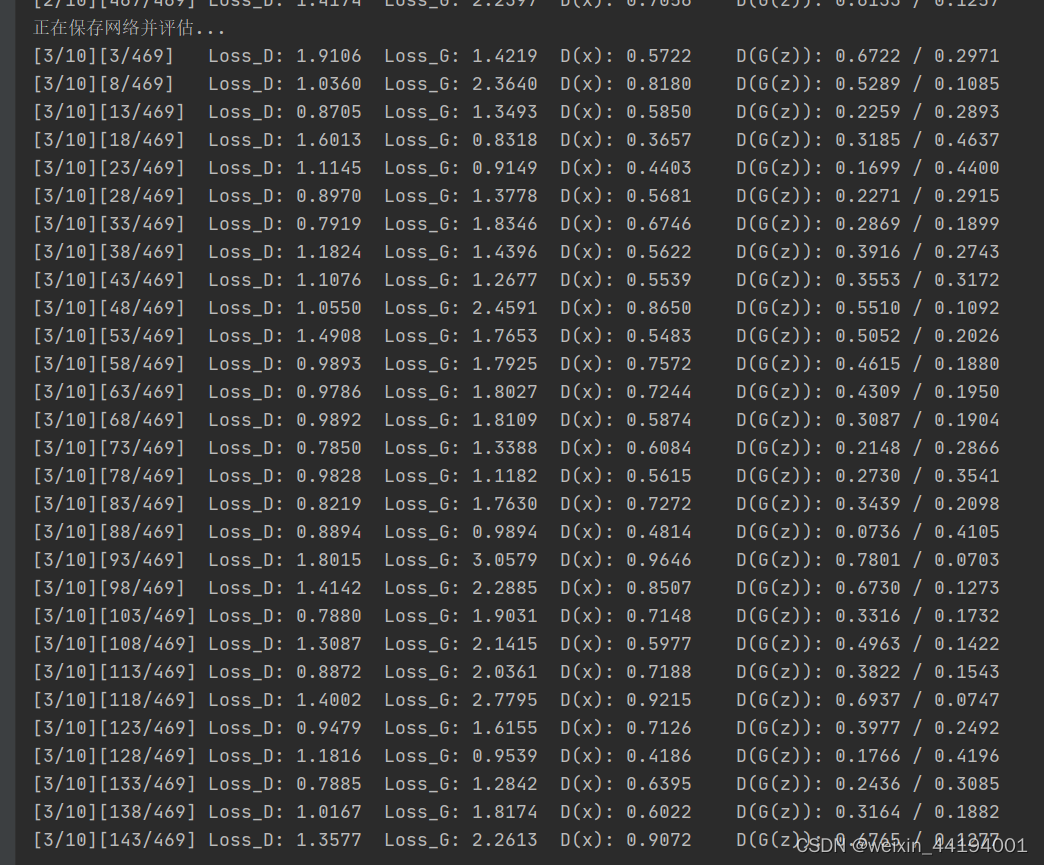
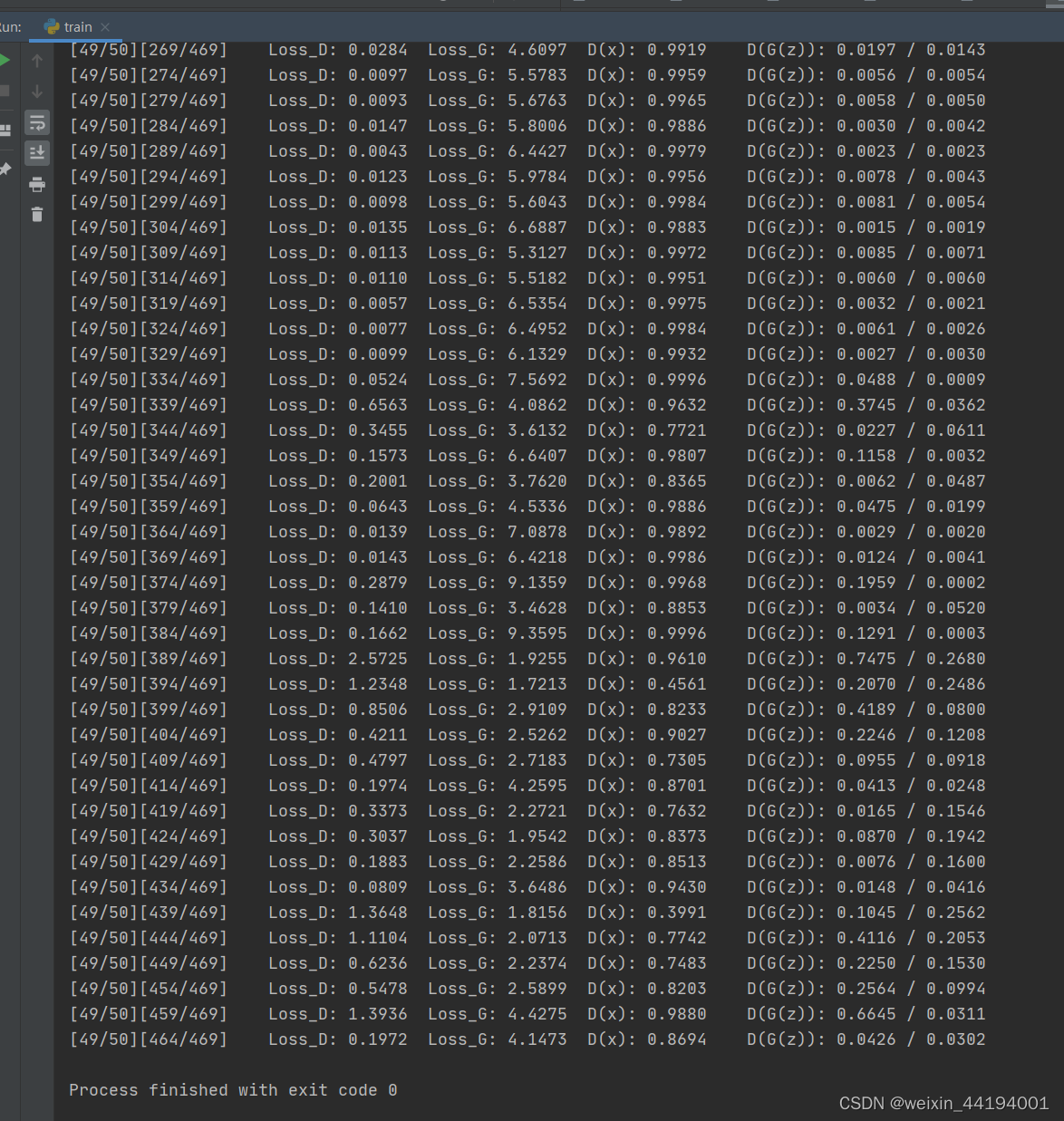
#errD是判别器识别真实图片和假图片的误差和,是为了训练判别器能够判别真假图片
#errG是判别器识别假图片的误差,但是是为了训练生成器生成假图片,以假乱真
#D_x就是判别器判别一批真图片为真的概率的平均值,训练判别器识别真图片
#D_G_z1就是判别器判别一批假图片为真的概率的平均值,训练判别器识别假图片
#D_G_z2就是判别器判别一批假图片为真的概率的平均值,训练生成器生成逼真的假图片
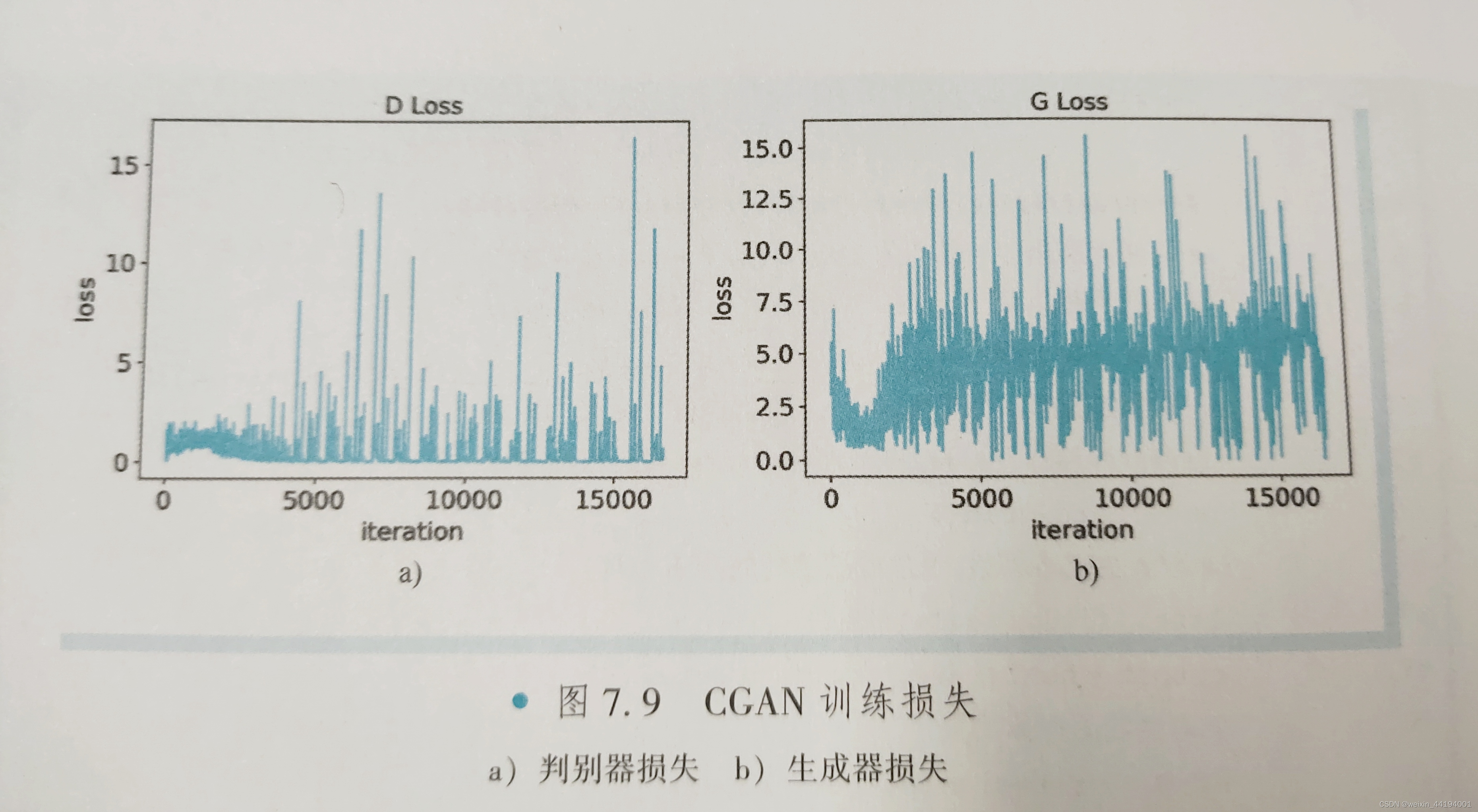


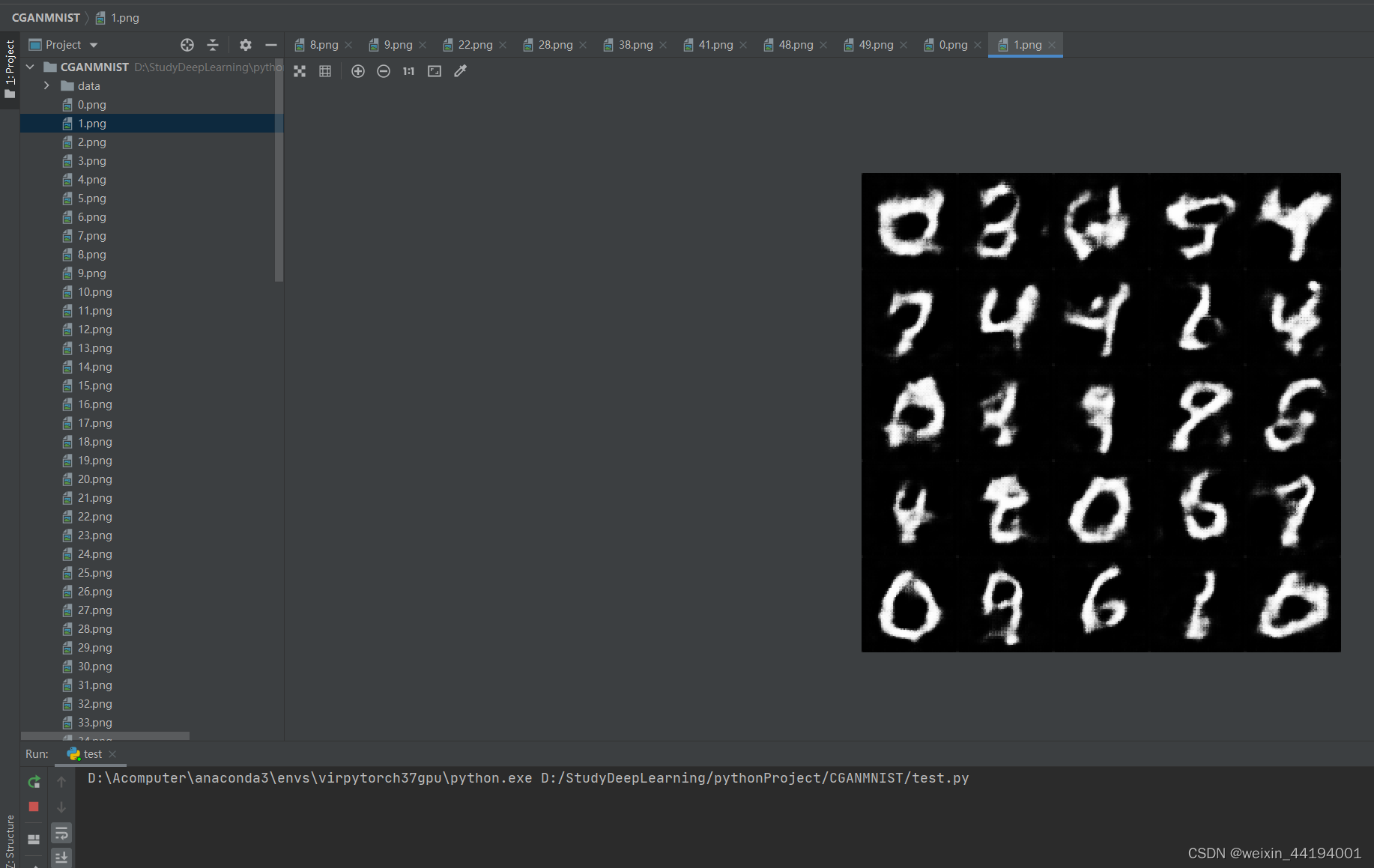




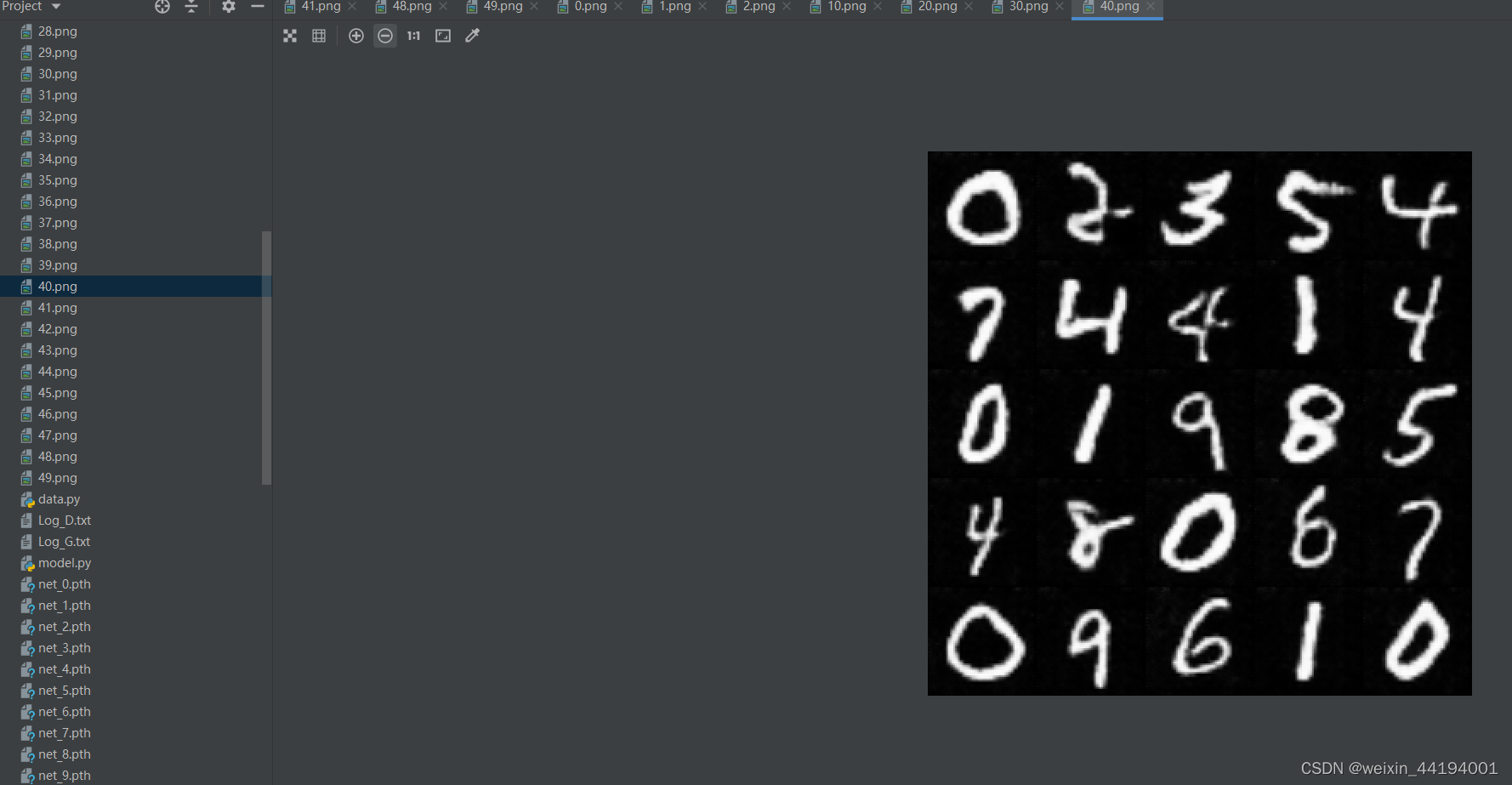
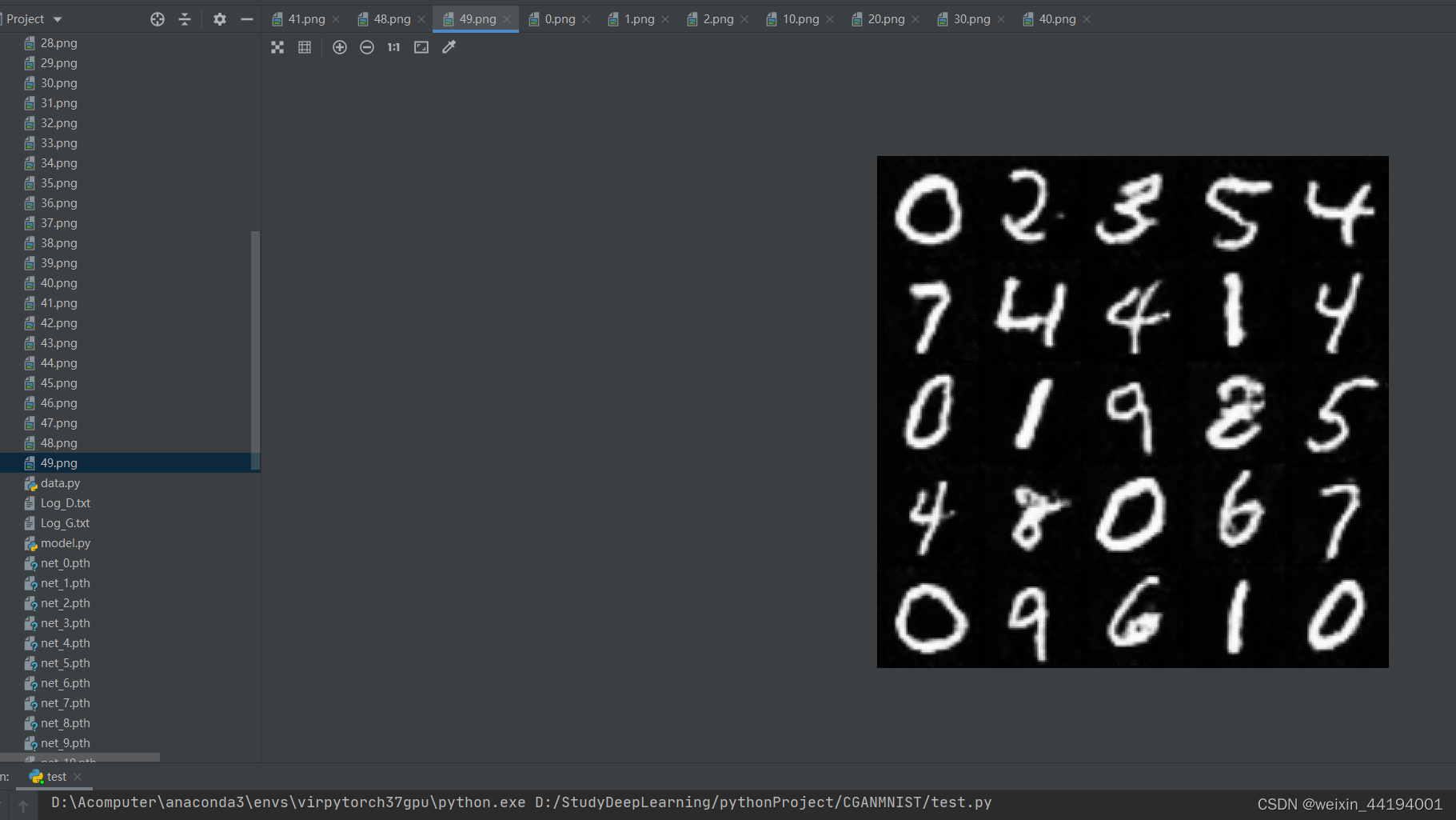
2.7测试结果

1)测试代码
NZ = 100
NUM_CLASS = 10
BATCH_SIZE = 10
DEVICE = "cpu"
netG = Generator()
netG = restore_network("./", "49", netG)
fix_noise = torch.randn(BATCH_SIZE, NZ, device=DEVICE)
fix_input_c = torch.tensor([0, 0, 0, 0, 0, 0, 0, 0, 0, 0])
device = "cuda" if torch.cuda.is_available() else "cpu"
fix_input_c = onehot(fix_input_c, NUM_CLASS)
fix_input_c = fix_input_c.to(device)
fix_noise = fix_noise.to(device)
netG = netG.to(device)
#fake_imgs = netG(fix_noise, fix_input_c).detach().cpu()
#fix_noise = torch.randn(BATCH_SIZE, NZ, device=DEVICE)
full_image = np.full((10 * 64, 10 * 64, 3), 0, dtype="uint8")
for num in range(10):
input_c = torch.tensor(np.ones(10, dtype="int64") * num)
input_c = onehot(input_c, NUM_CLASS)
fix_noise = fix_noise.to(device)
input_c = input_c.to(device)
fake_imgs = netG(fix_noise, input_c).detach().cpu()
images = recover_image(fake_imgs)
for i in range(10):
row = num
col = i % 10
full_image[row * 64:(row + 1) * 64, col * 64:(col + 1) * 64, :] = images[i]
plt.imshow(full_image)
plt.show()
plt.imsave("hah.png", full_image)
本文来自互联网用户投稿,该文观点仅代表作者本人,不代表本站立场。本站仅提供信息存储空间服务,不拥有所有权,不承担相关法律责任。 如若内容造成侵权/违法违规/事实不符,请联系我的编程经验分享网邮箱:veading@qq.com进行投诉反馈,一经查实,立即删除!
- Python教程
- 深入理解 MySQL 中的 HAVING 关键字和聚合函数
- Qt之QChar编码(1)
- MyBatis入门基础篇
- 用Python脚本实现FFmpeg批量转换
- 葡萄酒的主要区别只在于葡萄本身吗?
- Java 数据类型(无废话版)
- torch.optim.lr_scheduler.StepLR 的参数详解和应用
- 使用NVIDIA TensorRT-LLM支持CodeFuse-CodeLlama-34B上的int4量化和推理优化实践
- CentOS 7.9 安装PostgreSQL以及配置服务
- 【Spring】17 @Component 注解
- “超人练习法”系列09:耶克斯–多德森定律
- 不同路径I,II
- 【Python】P3 循环语句
- 保证Python3.8-3.11能用的dlib轮子